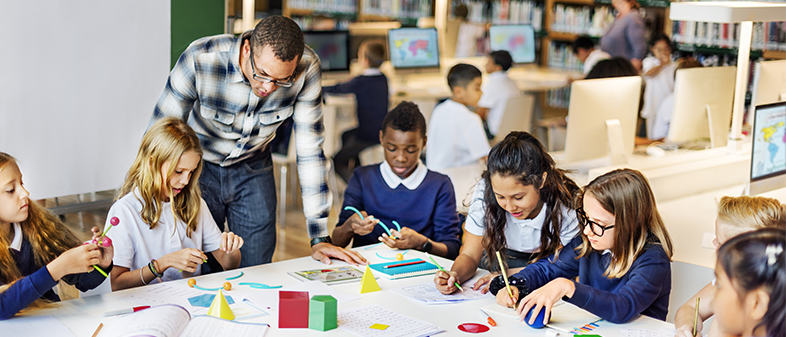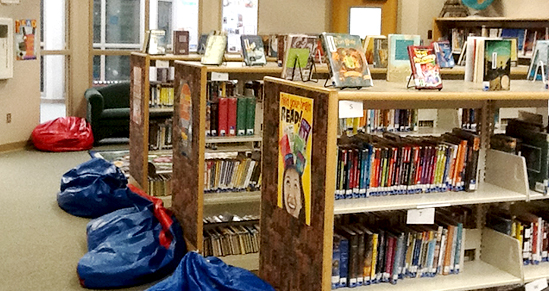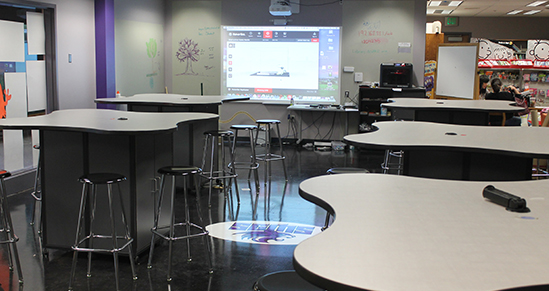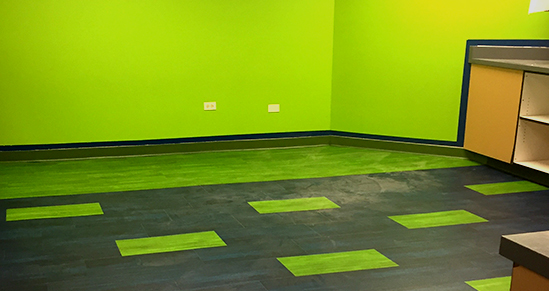
What do people see, and how do they feel when they enter your library? Every school library or media center I enter has a different feeling. The students have a feel for the space, visitors feel the vibe of the room and teachers know whether they are welcomed or not. I am sure each of you has heard the quote, "The library is the heart of the school". Think about your space and ask yourself: Is this the heart of the school or just another room in the building? I have been transforming learning spaces for five years, and have entered many rooms and thought, "this room needs help!"

In my position as the Learning Environment Designer, I am invited to schools to help with a transformation. Normally, upon entering the space, I have a feeling of what can be done - but I keep my thoughts to myself until after the vision is explained by either the librarian or principal. At the beginning of the meeting, I do a lot of listening, and to keep the conversation moving, I ask many questions. If possible, I arrive before the appointment so that I can observe how the students use the space. When we begin the discussion, I ask a few questions:
- What is your one-year vision?
- What is your five-year vision? (Hardly ever get an answer to this question.)
- How do you want the space to support student learning?
- What learning model is used in the building?
- How do you want the students and teachers to use the space?
- What type of spaces (zones) do you want in the space?
The answers to these questions and my observations let me know how well the vision has been developed.
When thinking about a transformation, it must be purposeful and support all students - not only the great readers but the non-readers, not only the studious students but the struggling students, not only the popular students but the less social students. For example, this was a vision described by an Assistant Principal at a K-6 school: "We want the space to be student-centered; we want the students comfortable in the space; we need a place for the students to be able to read comfortably and do research. This is also the only room in the building big enough to have monthly 30-minute staff meetings, so we will be purchasing only adult furniture." When there is a disconnect between the vision for the space and the needs of the principal, it is my job to represent the students. Biting my tongue hurts so much!
Prior to my current position, I was in an elementary library for nine years. I received a phone call and was asked to visit my previous school to transform the library. I walked in and thought, "it's perfect, why do we need to change?" It took me a few minutes to get over myself. Together, the principal, librarian and I developed a plan by talking about the vision and how the space would support the students as a combination library/makerspace. We developed a plan to have the adjacent computer room merge with the library/makerspace thus creating one large space with distinctive zones. Now, the space is so much more user friendly! The significance of this story is that sometimes you need a fresh set of eyes to see the possibilities of the space; don't be afraid to involve others to accomplish an extraordinary space that will support your students.
Some schools I have collaborated with have developed a committee of teachers, students, administrators, volunteers and community members. Committee members can be helpful when getting the message out to stakeholders. Having a variety of people with differing points of view is useful, as everyone sees through a different lens. It also takes some pressure off the librarian when making decisions that impact the entire school, such as whether to move from a fixed schedule to a flexible schedule. It's important to note that sometimes committee decisions come slowly; one school took three months to decide the color of the accent wall. I have found that collaborating with stakeholders is always a win-win for the students.
Library programming can make or break any great space. I have seen transformed spaces that were beautiful but without any fun events planned for the students the space is just like any other room in the building. Library programming can have several meanings such as, a student art exhibit or an author visit, or even a book fair. Programming or lack of programming can drive the vision. If the vision has been developed prior to the meeting, usually there has been some thought as to what the staff wants to add - such as, "we want a Makerspace but there is no room." Other times, programming has not even been given a thought. The lack of attention could be the result of many things: staffing or lack of proper staffing, library schedule, space considerations, uncertainty regarding new and innovative ways to support students and worst of all, "we have always done it this way why do we need to change?".
When working with a school, I need to make sure I am not guiding the conversation towards my personal preference. I am not in their school day-in and day-out, and my supervisor does not want cookie cutter libraries. Each school is different, and the vision should meet the needs of the students that attend that school.
Now, you may be wondering what happens if I ask, "What is your vision for the space?", and I get the glassy-eyed stare with mouths hanging open: "Ugh we don't have one." No, I do not get up and leave and tell them to call me when they have it figured out! We work together to develop a vision and sometimes they are not sure how to articulate what they want. First, I gather some information about the school: what is the teaching model (IB, Design Thinking, Case Based Learning, PBL etc.), library schedule (fixed, flexible or in a rotation), if staff have other responsibilities outside the library and any other information I need to know. In this scenario, I ask a lot of leading questions.
For instance:
- If this was a brand-new school with no limits what would you do?
- Imagine if I took this room and turned it upside down and shook everything out - how would you start over?
- What are the zones that you want in the space?
- If we plan for that zone, how will it support students?
Sometimes, we need to explore the various types of zones that would support student learning. Some of the popular choices are:
Makerspace zone - probably has the most educational buzz now. This space can provide students an option to show their learning differently. In many educational models, a makerspace is necessary. This is NOT a craft area; there will be craft supplies in the makerspace, but making, tinkering and prototyping should have a purpose.

Collaborative small group zone - can be an area for students to collaborate on a project with or without technology. I like to place old computer monitors on computer tables in these areas so the students can share their screens.
Recording zone for audio or video - this zone works wonderfully with a makerspace. Recording allows students to demonstrate how or why they built a prototype, show what they learned, and explain their research. Audio recording areas can be anything from a large box lined with foam to a complete sound board with digital microphones. For video recording, we do an accent wall with green paint for a green screen.

Connecting globally zone - Skype or Google hangout space so that students can connect with real world experts, connect with other classrooms from around the globe or attend global field trips.
Geek out zone - have students help other students with tech issues. Can also be a space for tech savvy students to hang out.
Some other more self-explanatory zones:
- Research or curating zone
- Listening zone
- Brainstorming zone
- Whole group instruction zone
- STEM/STEAM/STEAM zone
- Personal device charging zone
- Small group instruction zone
- Cyber cafe zone
- Student lounge zone
Creating the vision for a space can be difficult, but it will also build excitement for the process of transformation. The vision will serve as a blueprint to guide the entire process of supporting student learning for years to come. There could be resistance from staff, parents, and sometimes students. Change is hard. Many times, you may ask yourself, "WHY am I doing this?". Have conversations and rely on your support systems. If you make all decisions by asking, "What is best for kids?", you will not go wrong!


